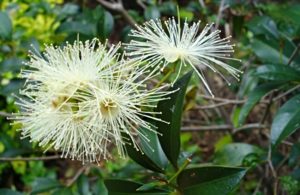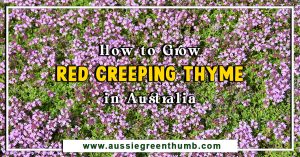Geraldton wax is a pretty Australian shrub and popular cut flower. The plant is a showstopper, which blooms for an extended period and will bring some fantastic colour to your garden.
This hardy and attractive native plant is easy to grow in the right conditions and will thrive with little ongoing maintenance. It works equally well in the garden as a feature shrub or as a potted plant and is a great choice for dry temperate gardens.
Read this garden guide for everything you need to know to successfully grow Geraldton waxflower.
More...
Genus: | Chamelaucium |
|---|---|
Species: | C. uncinatum |
Common name: | Geraldton wax |
Family: | Myrtle |
Plant type: | Shrub |
Sun: | Full sun |
Soil: | Well-drained |
Soil pH: | Acid, neutral or alkaline |
Height: | 2.5m |
Spread: | 2m |
Maintenance: | Low |
Poisonous to pets: | No |
Introducting Geraldton Wax
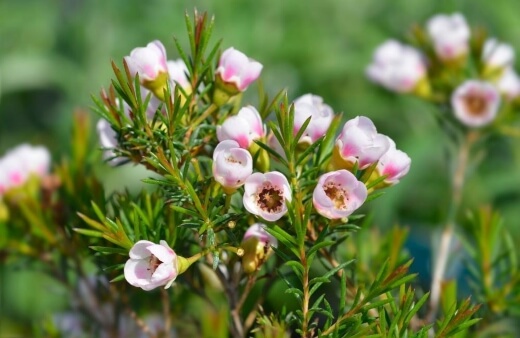
Chamelaucium uncinatum is a species of the Myrtaceae or the myrtle family of shrubs and trees. It is commonly known as Geraldton wax, Geraldton waxflower and Chamelaucium waxflower.
Chamelaucium is an attractive Western Australian shrub or small tree with fine needle-like leaves and waxy flowers in white, pink or red. The wax flower plant leaves are fragrant when crushed. They are also edible and have a citrus taste.
There are over 400 hybrids and varieties of Chamelaucium uncinatum, with over 20 varieties grown and sold commercially. This perennial native plant grows to a height of between 1m-5m and can spread to a similar width.
Geraldton waxflower is suitable for dry temperate climates. This perennial evergreen shrub does especially well in areas of the country with long, dry summers.
Geraldton wax plants dislike summer humidity and can be short-lived in humid areas. The plant won’t grow well in sub-tropical and tropical Australia and is not recommended for these areas of Australia.
Chamelaucium waxflower plants are drought tolerant when established. The plant will also tolerate light frost.
Geraldton Wax Varieties
Here are some popular Chamelaucium uncinatum to choose from:
Chamelaucium ‘Chantilly Lace’This hybrid has masses of buds that form clusters of pure white flowers with frilly edges and lime green middles. | 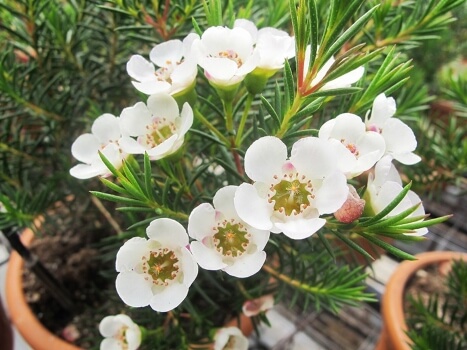 Source: floraccess.com |
Chamelaucium ‘Dancing Queen’Produces flowers that range in colour from soft baby pink through to bright candy-pink. |  Source: australianplantsonline.com.au |
Chamelaucium ‘Moonlight Delight’Produces an abundance of red buds in mid-winter, and this is followed by white flowers with dark crimson middles in early spring. | 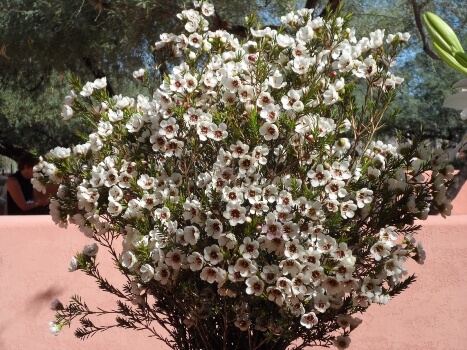 Source: gardenfeast.com.au |
Chamelaucium ‘My Sweet 16’My sweet 16 has pure white flowers which appear in early spring. The flowers later become a crimson colour, which means you have a colour palette of crimson, white and all shades in-between. |  Source: crosscommonnursery.co.uk |
Chamelaucium ‘Purple Pride’This hyrbid has purple flowers that mature to a dark magenta. |  Source: monrovia.com |
Chamelaucium ‘Raspberry Ripple’Raspberry ripple is a beautiful screening plant, with dark pink-crimson flowers on thin stems. | 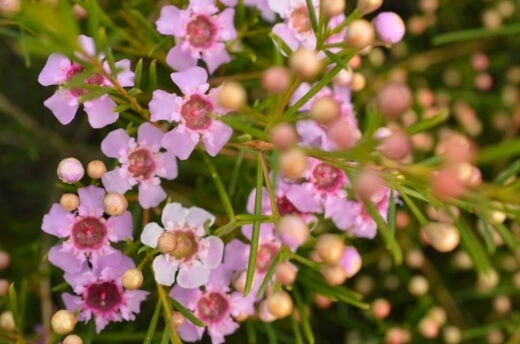 Source: guildfordgardencentre.com.au |
Chamelaucium Sarah's DelightThis hybrid is a tall shrub which produces loads of bright pink flowers with dark crimson middles during late winter and early spring. | 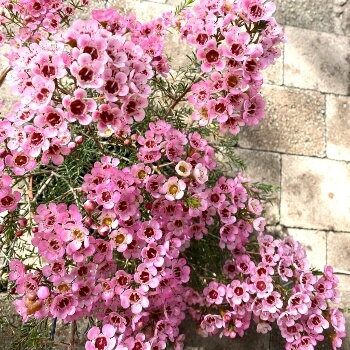 Source: capegardencentre.co.za |
Chamelaucium ‘Strawberry Surprise’Straberry suprise has gorgeous pink flowers with frilly petals. The flowers are abundant in spring. | 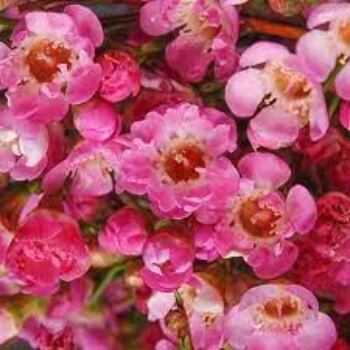 Source: guildfordgardencentre.com.au |
Chamelaucium ‘Chantilly Lace’

Source: floraccess.com
This hybrid has masses of buds that form clusters of pure white flowers with frilly edges and lime green middles.
Chamelaucium ‘Dancing Queen’

Source: australianplantsonline.com.au
Produces flowers that range in colour from soft baby pink through to bright candy-pink.
Chamelaucium ‘Moonlight Delight’

Source: gardenfeast.com.au
Produces an abundance of red buds in mid-winter, and this is followed by white flowers with dark crimson middles in early spring.
Chamelaucium ‘My Sweet 16’

Source: crosscommonnursery.co.uk
My sweet 16 has pure white flowers which appear in early spring. The flowers later become a crimson colour, which means you have a colour palette of crimson, white and all shades in-between.
Chamelaucium ‘Purple Pride’

Source: monrovia.com
This hyrbid has purple flowers that mature to a dark magenta.
Chamelaucium ‘Raspberry Ripple’

Source: guildfordgardencentre.com.au
Raspberry ripple is a beautiful screening plant, with dark pink-crimson flowers on thin stems.
Chamelaucium Sarah's Delight

Source: capegardencentre.co.za
This hybrid is a tall shrub which produces loads of bright pink flowers with dark crimson middles during late winter and early spring.
Chamelaucium ‘Strawberry Surprise’

Source: guildfordgardencentre.com.au
Straberry suprise has gorgeous pink flowers with frilly petals. The flowers are abundant in spring.
How to Grow Geraldton Wax in Australia
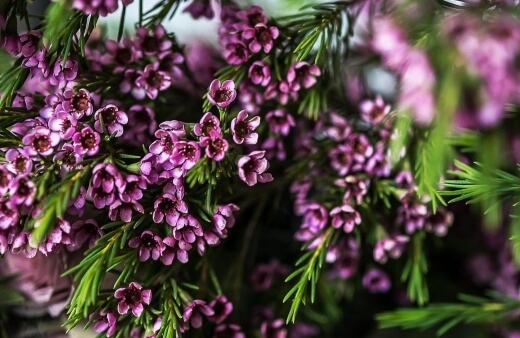
The Best Soil for Geraldton Wax
Geraldton wax plants need well-drained soil to thrive. A light, loose sandy soil is ideal. This native plant will do okay in most soil types if they drain well and don’t become waterlogged.
Areas with heavy clay soil often find Chamelaucium uncinatum a difficult plant to grow. Geraldton wax has low nutritional requirements and will grow well in poor soil.
Where to Position Geraldton Waxflower in Your Garden
The best place to plant Geraldton wax is in a sunny spot in the garden with well-drained soil. While Chamelaucium waxflower does best in full sun, it will also tolerate light, part-day shade, and still grow well. Avoid damp areas of deep shade.
Position the plant in a sheltered position that is protected from the wind. Geraldton waxflower has a brittle root structure and can be prone to toppling over in high wind. The plant may need some support.
Chamelaucium uncinatum can bring lots of colour and texture to the garden. They look great planted in a group or as individual specimens. Geraldton wax is the perfect companion plant for other natives like Leptospermum Pink Cascade or Grevilleas.
Growing Geraldton Wax in a Pot

Geraldton wax plants are suitable to be grown in a pot or large container if you have limited space in the garden. Growing Geraldton wax in a pot is also a good choice if your garden has unsuitable heavy, clay-based soil.
As noted, these plants hate waterlogged soil so avoid getting a container that is too large. This will make it difficult to control moisture levels and increase the potential risk of root rot. Choose a pot not bigger than twice the size of its current container.
Geraldton wax needs well-draining soil to grow well, so choose a free-draining native potting mix. If making your own mix two parts of washed sand with three parts of general-purpose mix.
When growing Geraldton wax in a pot you will also need to keep the size of the plant under control and trim back harder than you would if it was planted in the garden. Cut back up to one-third of the foliage each year after flowering to maintain the desired size plant.
How to Care for Geraldton Wax
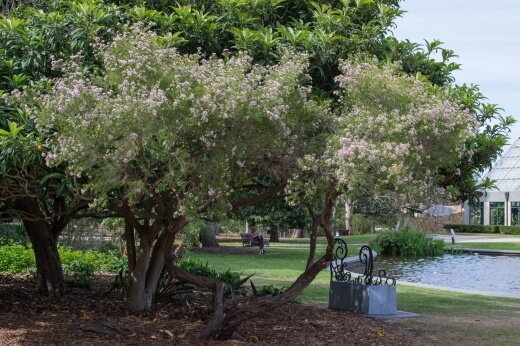
Source: iplantz.com
Geraldton wax is an easy to care for, low-maintenance native with minimal water needs. Until the plant becomes established in your garden, you will need to water regularly.
As the plant develops you should avoid over-watering as the native requires little water once established. Water during extended hot, dry periods but otherwise rainfall should be sufficient to keep the plant happy. Mulching around the root zone will help retain water.
These native plants can grow quite happily in poor soil so don’t need lots of fertiliser. If you do feel the need to give Geraldton Was a helping hand, use only fertiliser with a low phosphate content.
An all-purpose Australian native plant fertiliser can be applied during spring. Avoid fertilisers with lots of nitrogen as this will result in excessive tip growth and impact flowering.
After flowering it’s a good idea to give the plant a light trim. Pruning will keep the Geraldton waxflower bushy, dense, and healthy. If left alone, the plant can get large and woody. A trim will encourage lots of fresh growth and flowers next season.
Chamelaucium is hardy and typically problem-free if planted in well-draining soil. It can be susceptible to root rot if sitting in waterlogged soil or grown in humid wet conditions.
Ongoing damp ground can kill an established plant. Otherwise, this wax flower plant is generally free from issues with pests and diseases.
When does Geraldton Wax flower?
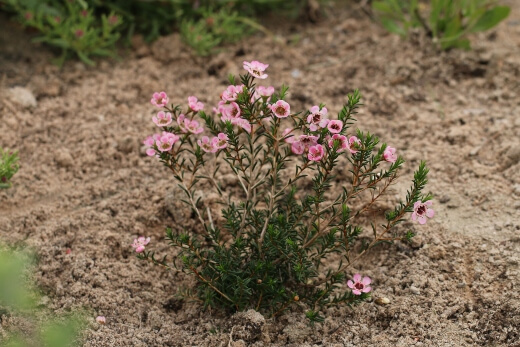
Source: inaturalist.nz
This is an attractive plant all year round but really comes into its own when flowering. This wonderful feature shrub blooms for an extended period from late winter to spring. The blooms cover the plant, making it one of the showiest native plants around and deserving of accolades as one of Australia’s most famous wildflowers.
The flowering stems come in a range of colours. While the pink-flowered form is the most common, other varieties of Geraldton wax are available in other colours including white and deeper purples.
Chamelaucium flowers last a long time after cutting, making them extremely popular cut flowers. They are commonly used in flower arrangements as backing for single-stemmed flowers like roses or kangaroo paws. If picking the flowers for display it is best to wait until around a third of the bloom has opened.
Bees, birds, butterflies, and other native wildlife love the flowers too!
Geraldton Wax as Bush Tucker
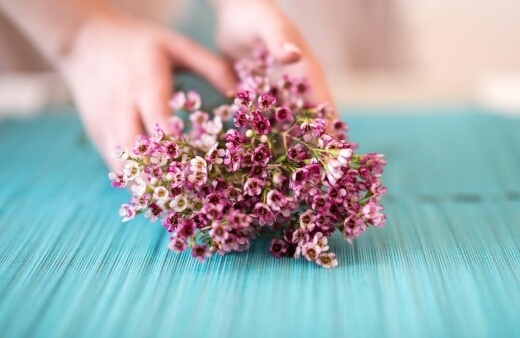
The leaves of the Geraldton wax taste like a lemony pine needle. They are delicious with seafood and stuffed in whole fish. The flowers are also edible, just not in large amounts.
The leaves contain oil glands and give off a beautiful perfume when crushed. Geraldton wax adds a citrus flavour to beverages and meals and can be added to stir fries and creamy seafood sauces.
The taste profile is zesty with citrus notes and is thought of as Australia's version of kaffir lime. (If you're interested, find out more about kaffir limes here.)
The leaves can be dried and ground, ready to use as a spice when needed. While the leaves of the plant have been used to flavour food, no evidence has been found yet of the Indigenous use of Geraldton wax flowers as a food.
You use the leaf in the same way you would use rosemary. You strip the leaf, blend it with some oil and a pinch of salt and create a green salsa-verde paste which tastes great with fish, prawns or lamb.
The leaves have been used in the food industry as a flavouring for sauces, stocks and in a botanical gin. You can now even find dried tea flakes, and a freeze-dried powder for pancake and biscuit batter.
You’ll be amazed at the world of Australian bushes once you start exploring it. Our articles have great information about how to identify and use native fruits, trees and plants. Check out our collection of Australian bush tucker.
Common Geraldton Wax Pests and Diseases
The Geraldton wax plant doesn’t really suffer from any serious pests or diseases. It is however sensitive to root rot fungus (Phytophthora spp.), making them difficult to grow under humid summer conditions. Other than that, scale is the most common pest you might find.
Phytophthora Root and Stem Rot
Phytophthora root and stem rot is a soil-borne fungal disease caused by the pathogen Phytophthora and affects the plant at various growth stages. Development of the disease is fuelled by high soil temperatures and very moist soil.
Steam heat is effective to kill Phytophthora in contaminated soil or planting containers. If you re-use pots you can soak pre-cleaned pots in hot water for at least 30 min or use steam for 30 min.
The most effective way of preventing Phytophthora rot diseases is good drainage and water management.
Geraldton Wax Frequently Asked Questions
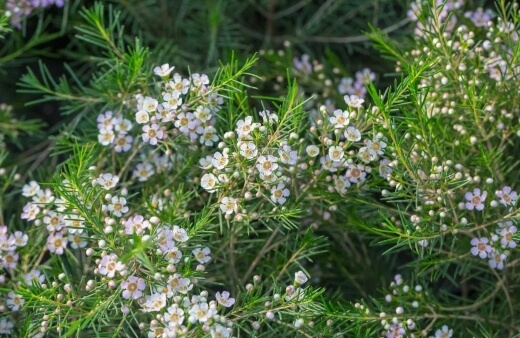
What is the most popular worldwide use of the Geraldton wax plant?
The Geraldton wax plant is one of Australia's most famous wildflowers and immensely popular in the cut flower industry throughout the world because the flowers last extremely well in a vase.
It was popular in California dating back to the 1940’s, and was introduced into Israel in the 1970’s. Today, it is widely grown in many countries, including South Africa, Chile and Peru.
Does Geraldton wax have any medicinal uses?
There are no known medicinal uses for Geraldton wax but it does contain natural anti-fungal properties that promote wound healing. The flower essence oil is used in aromatherapy for mental and emotional health.
Where does the scientific name for the Geraldton wax come from?
The name uncinatum means "hooked" in Latin, and refers to the tips of the leaves.

Now You Know How to Grow Geraldton Wax
Geraldton wax is an easy to grow native plant that will look great in your garden. Simply plant in an area of the garden with lots of sun and well-draining soil and the waxflower should thrive.
This low maintenance native doesn’t need to be fed fertiliser regularly and is drought tolerant. It is a very low fuss plant that just needs a light trim after flowering. Easy!
If you have any questions or need further information about how to grow Geraldton wax in your garden or a container pot, get in contact with us.
Published on June 20, 2022 by Nathan Schwartz
Last Updated on February 26, 2024

